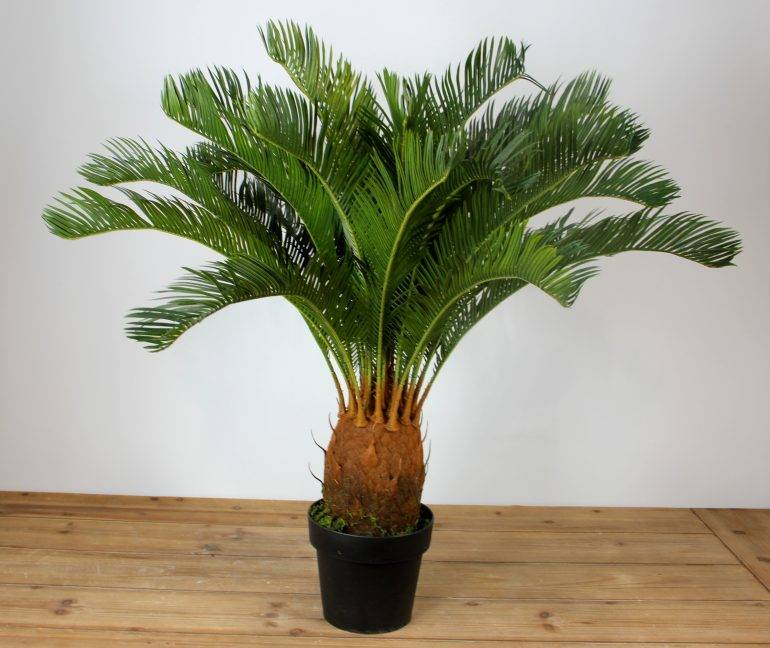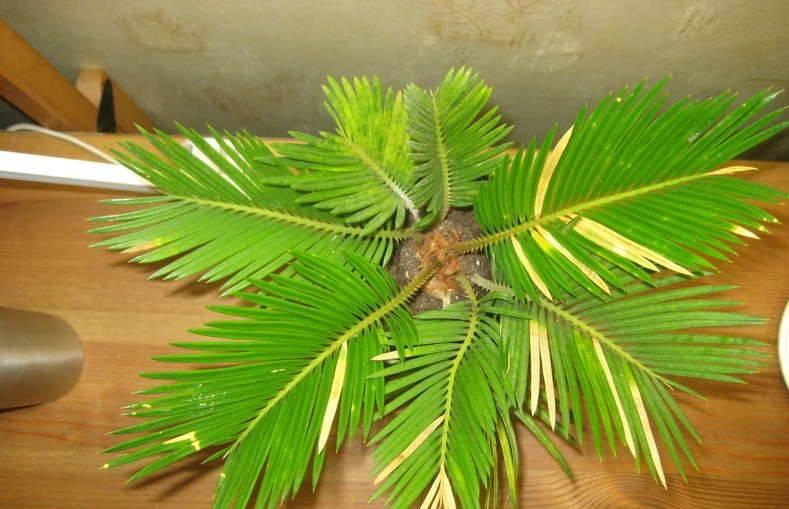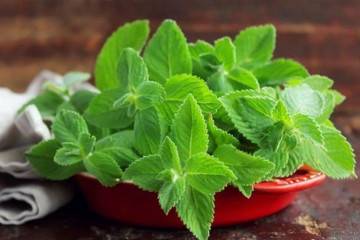Cycas flower - how to care for a sago palm
Content:
Tsikas is an exquisite and noble flower. Novice flower growers in rare cases decide to purchase, fearing his capricious disposition. But such assumptions are completely unfounded. Growing cicasas is easy enough. The most important thing is to provide him with the required care and conditions of detention.
What is a sago palm
The cicas palm belongs to the Sagovnikov family. The plant is considered one of the oldest in the world. Because of its appearance, the flower is often called a sago palm. The plant grows in height from 2 to 7 meters. The trunk is crowned with a shock of carved leaves and reaches 80 cm in diameter.
Outwardly, the cicas houseplant is very similar to a palm tree, but it has absolutely nothing to do with it. If you watch how the leaves of this flower bloom, you may get the impression that he belongs to ferns, but he has nothing in common with them.
The cycad grows very slowly, only one corolla of leaves grows per year. The plant is difficult to reproduce.
Symmetrical thin leaves are attached to the central trunk, which last for a very long time, so from year to year the cicassus becomes more magnificent. Since the flower is an ornamental deciduous plant, it does not bloom.
As for the lifespan, this flower is a long-liver. Basically, the cicas has been growing for more than a century, but there are also specimens that are more than 5 thousand years old.
Cycas species with a short description
At room temperature, at present, only the following varieties of the cicas sago palm have been able to adapt.
Tsikas drooping (Cycas revolute)
The most common variety, which has many names. He is called the sago palm, the Japanese sago palm, and the sago king. Among flower growers, this particular plant is very common.
This cicada is native to southern Japan. The flower bush develops symmetrically. During development, dark green leaves form on the thick, hairy trunk. Their length varies from 50 to 150 cm, and their shape resembles feathers. Representatives of the variety grow very slowly and reach full maturity only by the age of 50.
Curled cicas (Cycas circinalis / Cycas neocaledonika)
The plant grows to a height of 8 meters. Leaves with many thorns develop exclusively in a vertical plane, and subsequently begin to be located parallel to the ground. Their shade is distinguished by original transitions from light to dark to the edge.
A feature of this variety is the formation of a large number of floating seeds and babies.
Cicas medium (Cycas media)
This species reaches a height of 7 meters and is often used for park landscaping. A distinctive feature of the plant is its elegant arch-like curvature of the leaves.
Cycas rumphii
The homeland of this species is Sri Lanka. The flower grows to a height of 15 meters and is considered the largest species of the Cycad. Leaves are bright green, glossy with a length of 150 to 250 cm.
Siamese cicas (Cycas siamensis)
One of the smallest cycads, its height does not exceed 1.6 m. In natural conditions, it grows in the territories of the countries of the Indochina Peninsula. The leaves of the flower are blue-white.
These are not all types of cicassa houseplants. Also, cicasa variegated, dimplofoliolum, golden beauty and corrugata are very popular among gardeners. It is quite possible to see how a cicasus of any of the listed species usually blooms if you take proper care of it.
Reproduction of an indoor cycad
Reproduction of cicas at home requires a lot of effort. This can be done in only two ways, with the help of seeds and children.
How to grow from seeds
Growing young plants from seeds at home is very problematic. This is explained, first of all, by the fact that a flower grown at home does not form organs of sexual reproduction and it is almost impossible to obtain seeds.
Basically, the cicassus is propagated by seeds on an industrial scale, after very costly and long-term activities.
You can buy ready-made seeds and try to germinate them at home. Subject to all the rules, you can try to achieve their germination. Mostly they order cicas palm seeds in Uzbekistan and China. The most important thing is to check their expiration date before planting.
Before planting in the ground, the seeds must be soaked for a day. After that, they must be deepened into the substrate and kept in a greenhouse in bright light and high temperatures. If everything is done correctly, the first shoots will appear in about two months.
Growing from scions
Most gardeners prefer vegetative propagation of cicas, as it is easier and more effective.
The flower independently provides planting material when bulbous processes appear at the base of the trunk. After their appearance, it is only necessary to carefully treat the relic.
Before the awakening of the leaf buds, in the period from late February to early March, the shoots must be carefully removed from the mother specimen. It is recommended to perform all actions with thoroughly disinfected instruments. Separated children must be disinfected and dried within 24 hours. After that, they can be treated with a growth stimulant and dried again.
As soon as all of the above actions are completed, they begin to deepen the seedlings into the ground and place them in a greenhouse with a high temperature, significant humidity and dim lighting.
Cycas flower: home care
To grow a cicassus, care must be taken in strict accordance with all requirements. Since the cycad grows slowly, it requires intensive feeding and optimal keeping conditions for its development.
Lighting and temperature control
The flower feels best in diffused lighting, but it can also grow and develop normally in partial shade. The only thing that flower growers recommend providing the plant every day is being in direct sunlight for four hours. If for a long time the flower is not under the bright sun, it will fall into a state of sleep, which is characterized by a slowdown in growth.
The most comfortable temperature for cicassa is considered to be from +17 to +20 degrees. In this case, it must be borne in mind that the temperature in the room where the flower grows should not fall below +13 degrees.
Watering and moisturizing
When growing a cicada flower, home care should include rare moisture in the soil and the creation of high humidity.When watering, it is strictly forbidden for moisture to get onto the crown. It is recommended to use only soft water at room temperature for irrigation.
To maintain the required humidity level, it is necessary to regularly spray the room with a fine spray bottle.
Top dressing
It is relatively easy to care for a cycad. As for dressings, fertilizer should be applied no more than once a month. Supplements are applied from mid-spring to early fall. Since at this time the cicas does not bloom, it is recommended to give preference to nitrogen mineral fertilizers.
Transplanting a palm tree, how to prepare the soil
Cycas should be transplanted regularly. The works are carried out once every 2-3 years. This only applies to young bushes. Mature plants are transplanted only if they are cramped in the old pot.
Before planting, you must carefully prepare the substrate. The soil should be water permeable and neutral or slightly acidic. The transplant can be done at any time when the need arises.
Pests and diseases
Scabbards are a huge danger to the flower, since they are covered with a wax coating and insecticidal preparations do not have a destructive effect on them. To combat these pests, insects are removed from the bush manually, and to destroy the larvae, the ground part of the bush is treated with a contact or systemic action.
Aphids can also settle on the plant. Phosphorus preparations will help to cope with the problem.
Cycas leaves turn yellow: what to do
If only the lower leaves of the plant turn yellow and the phenomenon is local in nature, then you should not worry. In this case, yellowed leaves are a normal process, which simply means that the old leaf has started to die off.
If all the leaves of a flower turn yellow at once, then rot may be the cause. The cause can be the ingress and accumulation of moisture at the top of the stem. As soon as yellow leaves appear, it is necessary to immediately clean up the damaged area, transplant and treat it with a fungicide. Among other things, the leaves can turn yellow from poor lighting.
Rotting of the lower part of the trunk and roots
One of the common problems that growers can face when growing cicas. The reason lies in improper watering. It is possible to save the plant if you immediately remove it from the flowerpot, and then remove the damaged areas. Then they usually treat the flower with a fungicide, sprinkle it with activated charcoal, dry it and move it to a new pot with fresh soil.
Tsikas belongs to relict plants that managed to survive several geological eras and at the same time retain their originality and exotic appearance. Its original trunk and interesting shape of beautiful emerald leaves are eye-catching and admirable.





















